CHEVROLET MONTE CARLO 1997 5.G Owners Manual
Manufacturer: CHEVROLET, Model Year: 1997, Model line: MONTE CARLO, Model: CHEVROLET MONTE CARLO 1997 5.GPages: 358, PDF Size: 19.11 MB
Page 121 of 358

Downloaded from www.Manualslib.com manuals search engine Comfort Controls
Air Conditioning with Electronic Controls
With these systems, you can control the heating, cooling
and ventilation in your vehicle. The systems work best
if
you keep your windows closed while using them.
Fan Knob
The right knob with the fan symbol selects the force of
air you want. To turn the fan off, turn the knob
to “0.”
Temperature Control
If your system does not have the auxiliary temperature
control option, the center knob changes the temperature
of the air coming through the system. Turn this knob
toward red (clockwise) for warmer air. Turn it toward
blue (counterclockwise) for cooler air.
If your system does have the auxiliary temperature
control option, the center levers change the temperature
of the air coming through the system. The
DRIV
lever sets the temperature for the driver and rear seat
passengers, and the
PASS lever sets the temperature
for the front seat passenger. For maximum defroster
performance, set the
DRIV and PASS levers at full warm.
Page 122 of 358
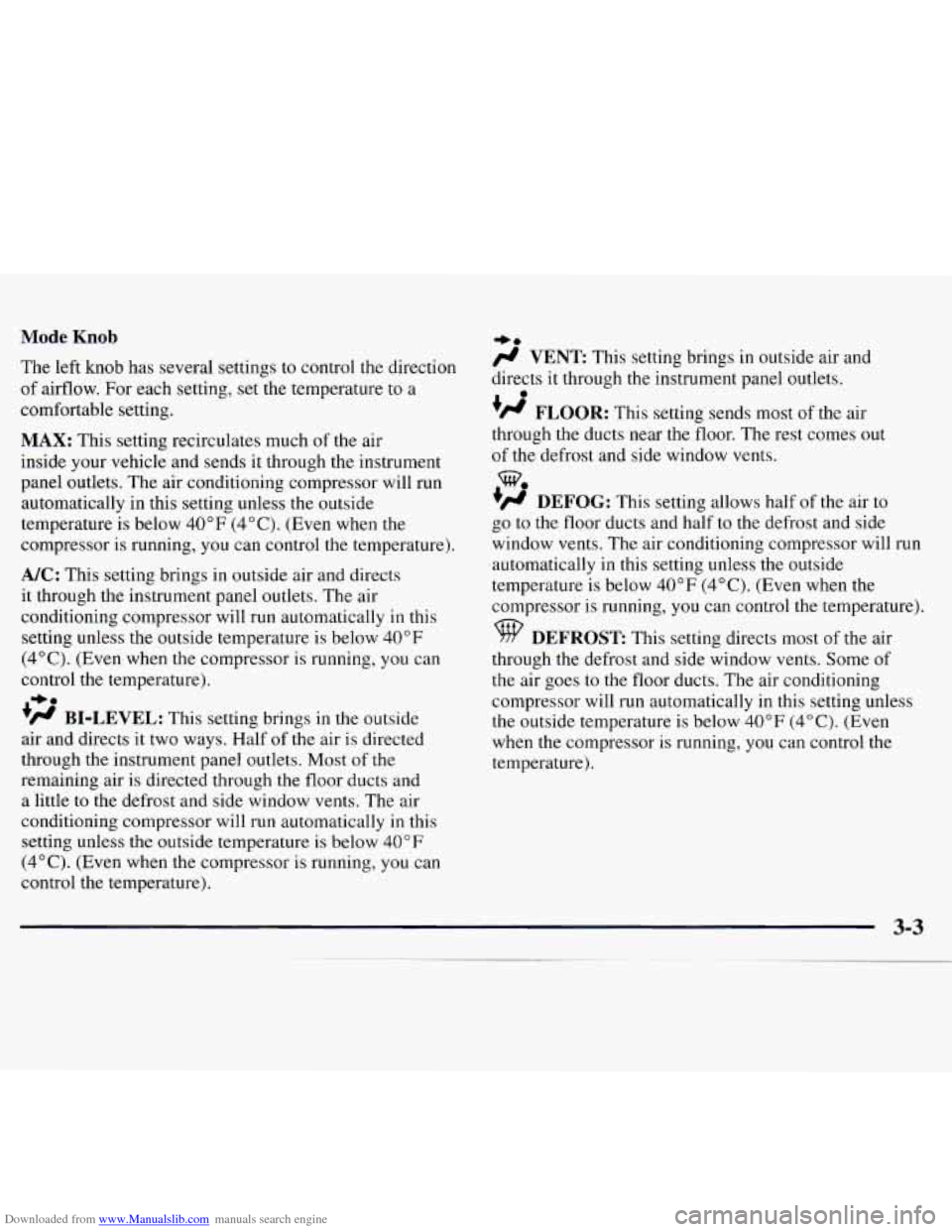
Downloaded from www.Manualslib.com manuals search engine Mode Knob
The left knob has several settings to control the direction
of airflow. For each setting,
set the temperature to a
comfortable setting.
MAX: This setting recirculates much of the air
inside your vehicle and sends it through the instrument
panel outlets. The air conditioning compressor will run
automatically in this setting unless the outside
temperature is below 40°F (4°C). (Even when
the
compressor is running, you can control the temperature).
A/C: This setting brings in outside air and directs
it through the instrument panel outlets. The air
conditioning compressor will run automatically
in this
setting unless the outside temperature is below 40°F
(4°C). (Even when the compressor is running, you can
control the temperature).
+' BI-LEVEL: This setting brings in the outside
air and directs it two ways. Half of
the air is directed
through the instrument panel outlets. Most
of the
remaining air is directed through
the floor ducts and
a little to the defrost and side window
vents. The air
conditioning compressor will run automatically
in this
setting unless
the outside temperature is below 40°F
(4°C). (Even when the compressor is running, you can
control the temperature).
+e +e
/J VENT This
setting brings in outside air and
directs
it through the instrument panel outlets.
'# FLOOR: This setting sends most of the air
through the ducts near the floor. The rest comes out
of
the defrost and side window vents.
$/J DEFOG: This setting allows half of the air to
go to the floor ducts and half to the defrost and side
window vents.
The air conditioning compressor will run
automatically
in this setting unless the outside
temperature is below 40°F (4°C). (Even when the
compressor is running, you can control the temperature).
DEFROST This setting directs most of the air
through the defrost and side window vents. Some of
the air goes to the floor ducts. The air conditioning
compressor
will run automatically in this setting unless
the outside temperature is below 40°F
(4°C). (Even
when the compressor is running, you can control the
temperature).
0
we
3-3
Page 123 of 358
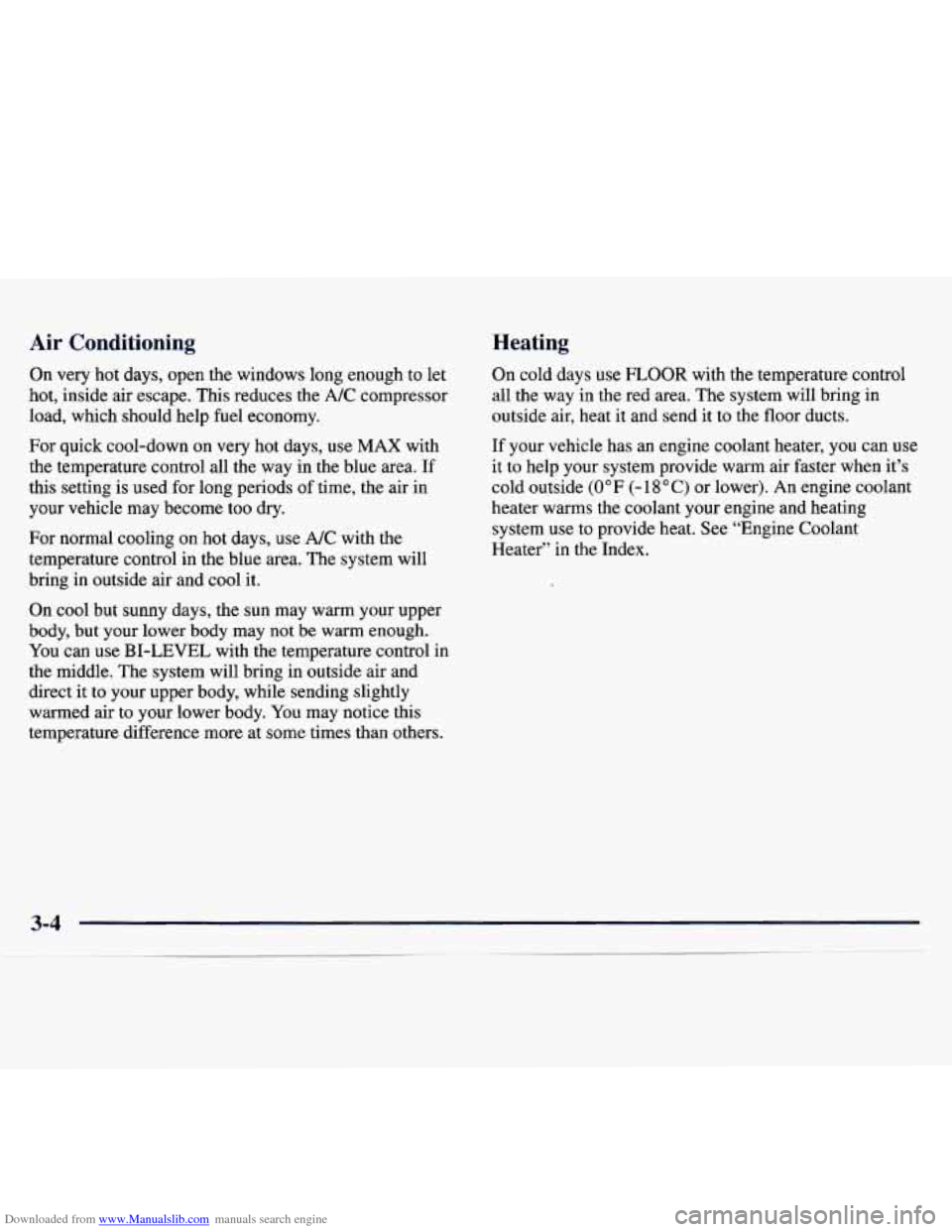
Downloaded from www.Manualslib.com manuals search engine Air Conditioning Heating
On
very hot days, open the windows long enough to let
hot, inside air escape. This reduces the A/C compressor
load, which should help fuel economy.
For quick cool-down on very hot days, use MAX with
the temperature control all the way
in the blue area. If
this setting is used for long periods
of time, the air in
your vehicle may become too dry.
For normal cooling on hot days, use A/C with the
temperature control in the blue area. The system will
bring in outside air and cool it.
On cool but sunny days, the sun may warm your upper
body, but your lower body may not be warm enough.
You can use BI-LEVEL with the temperature control in
the middle. The system will bring in outside air and
direct
it to your upper body, while sending slightly
warmed air to your lower body. You may notice this
temperature difference more at some times than others. On cold days
use FLOOR with
the temperature control
all the way in the red area. The system will bring in
outside air, heat
it and send it to the floor ducts.
If your vehicle has an engine coolant heater, you can use
it to help your system provide warm air faster when it’s
cold outside
(0°F (-18°C) or lower). An engine coolant
heater warms the coolant your engine and heating
system use to provide heat. See “Engine Coolant
Heater”
in the Index.
Page 124 of 358
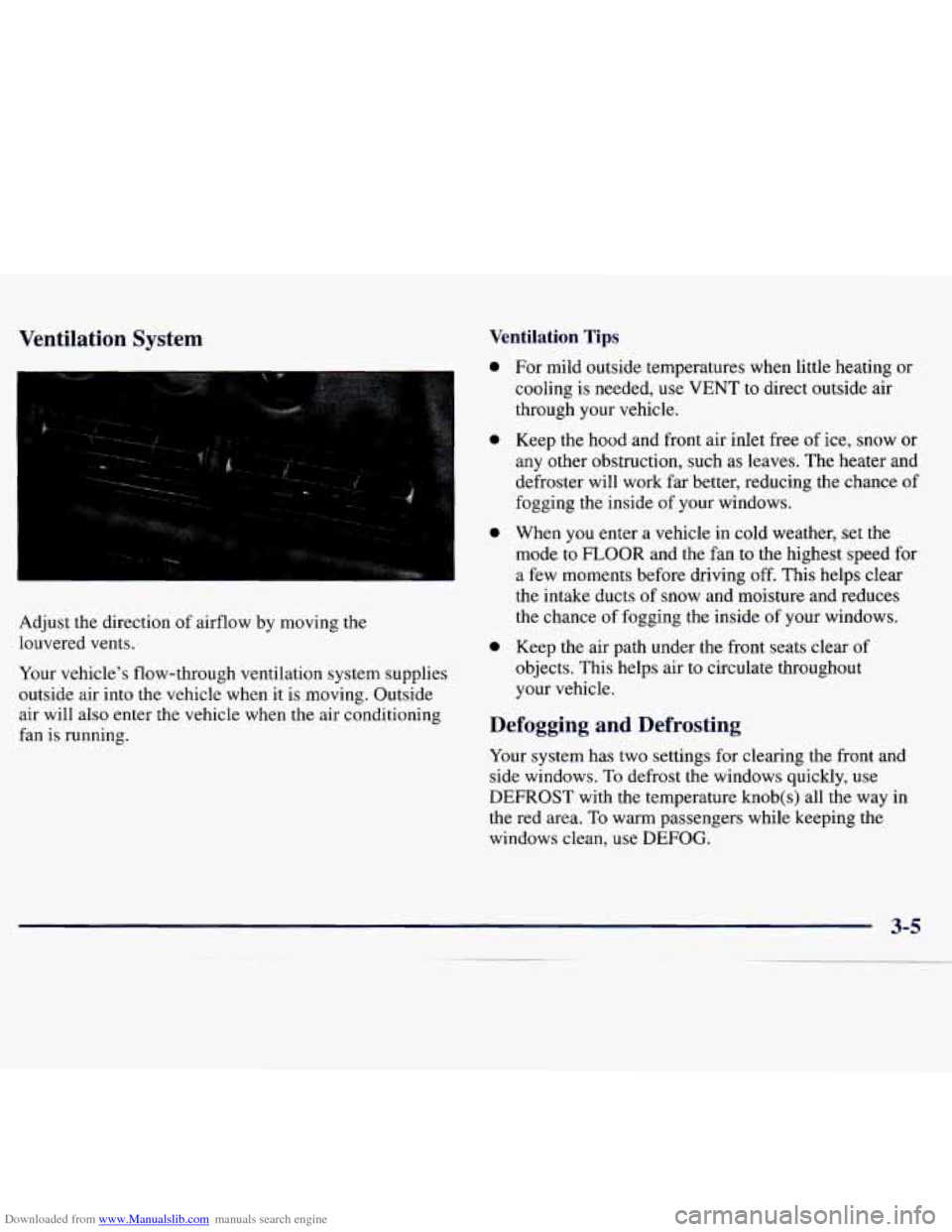
Downloaded from www.Manualslib.com manuals search engine Ventilation System
L
Adjust the direction of airflow by moving the
louvered vents.
Your vehicle’s flow-through ventilation system supplies
outside air into the vehicle when it is moving. Outside
air will also enter the vehicle when the air conditioning
fan is running.
Ventilation Tips
0
0
0
0
For mild outside temperatures when little heating or
cooling is needed,
use VENT to direct outside air
through your vehicle.
Keep the hood and front air inlet free
of ice, snow or
any other obstruction, such
as leaves. The heater and
defroster will work far better, reducing the chance
of
fogging the inside of your windows.
When you enter a vehicle in cold weather, set the
mode
to FLOOR and the fan to the highest speed for
a few moments before driving off. This helps clear
the intake ducts
of snow and moisture and reduces
the chance of fogging the inside of your windows.
Keep the air path under the front seats clear of
objects. This helps air to circulate throughout
your vehicle.
Defogging and Defrosting
Your system has two settings for clearing the front and
side windows.
To defrost the windows quickly, use
DEFROST with the temperature knob(s) all the way in
the red area.
To warm passengers while keeping the
windows clean, use
DEFOG.
3-5
Page 125 of 358
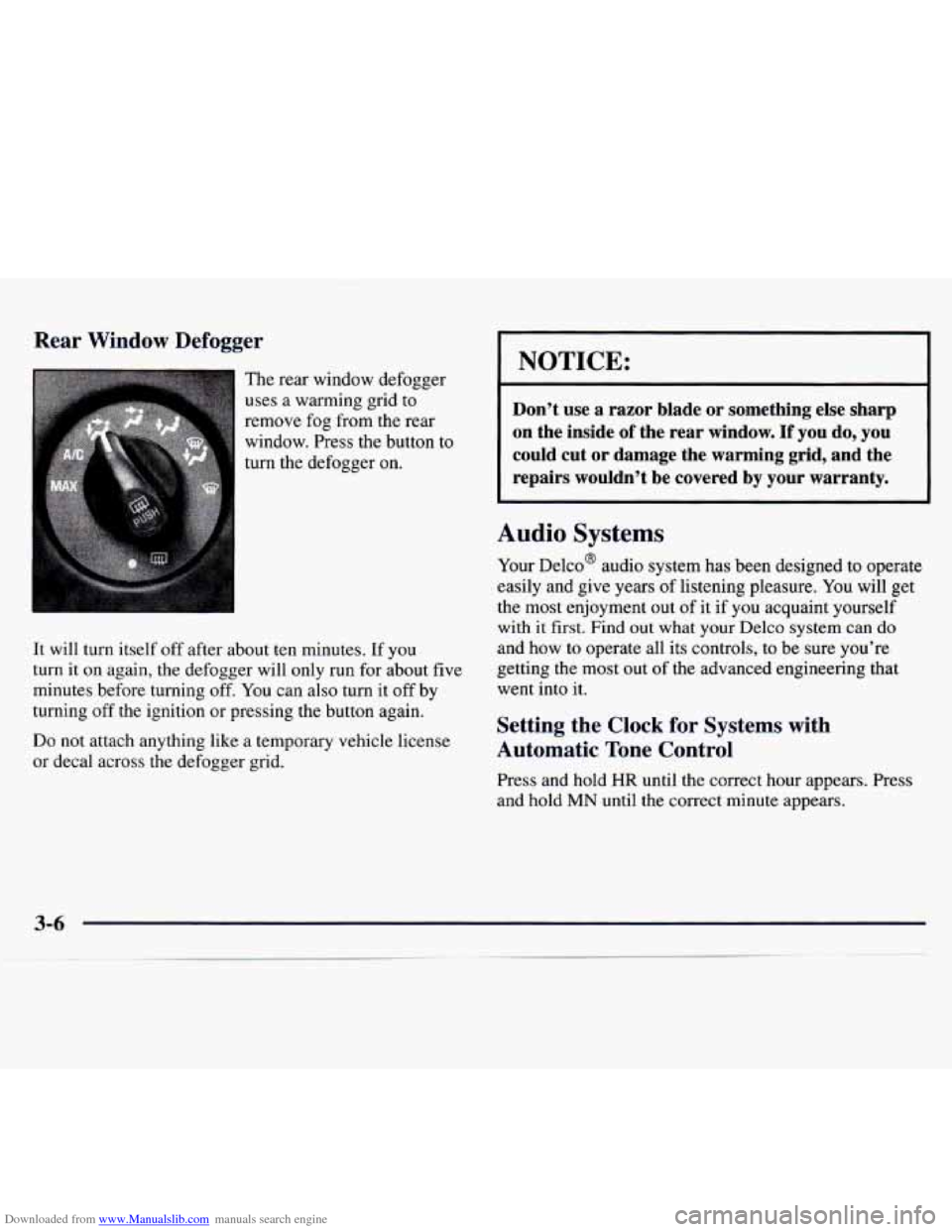
Downloaded from www.Manualslib.com manuals search engine Rear Window Defogger
The rear window defogger
uses a warming grid to
remove fog from the rear
window. Press the button to
turn the defogger on.
It will turn itself off after about ten minutes. If
you
turn it on again, the defogger will only run for about five
minutes before turning off.
You can also turn it off by
turning off the ignition or pressing the button again.
Do not attach anything like a temporary vehicle license
or decal across the defogger grid.
NOTICE:
Don’t use a razor blade or something else sharp
on the inside
of the rear window. If you do, you
could cut or damage the warming grid, and the
repairs wouldn’t be covered by your warranty.
Audio Systems
Your Delco@ audio system has been designed to operate
easily and give years
of listening pleasure. You will get
the most enjoyment out of it if
you acquaint yourself
with it first. Find out what your Delco system can
do
and how to operate all its controls, to be sure you’re
getting the most out of the advanced engineering that
went into it.
Setting the Clock for Systems with
Automatic Tone Control
Press and hold HR until the correct hour appears. Press
and hold
MN until the correct minute appears.
Page 126 of 358
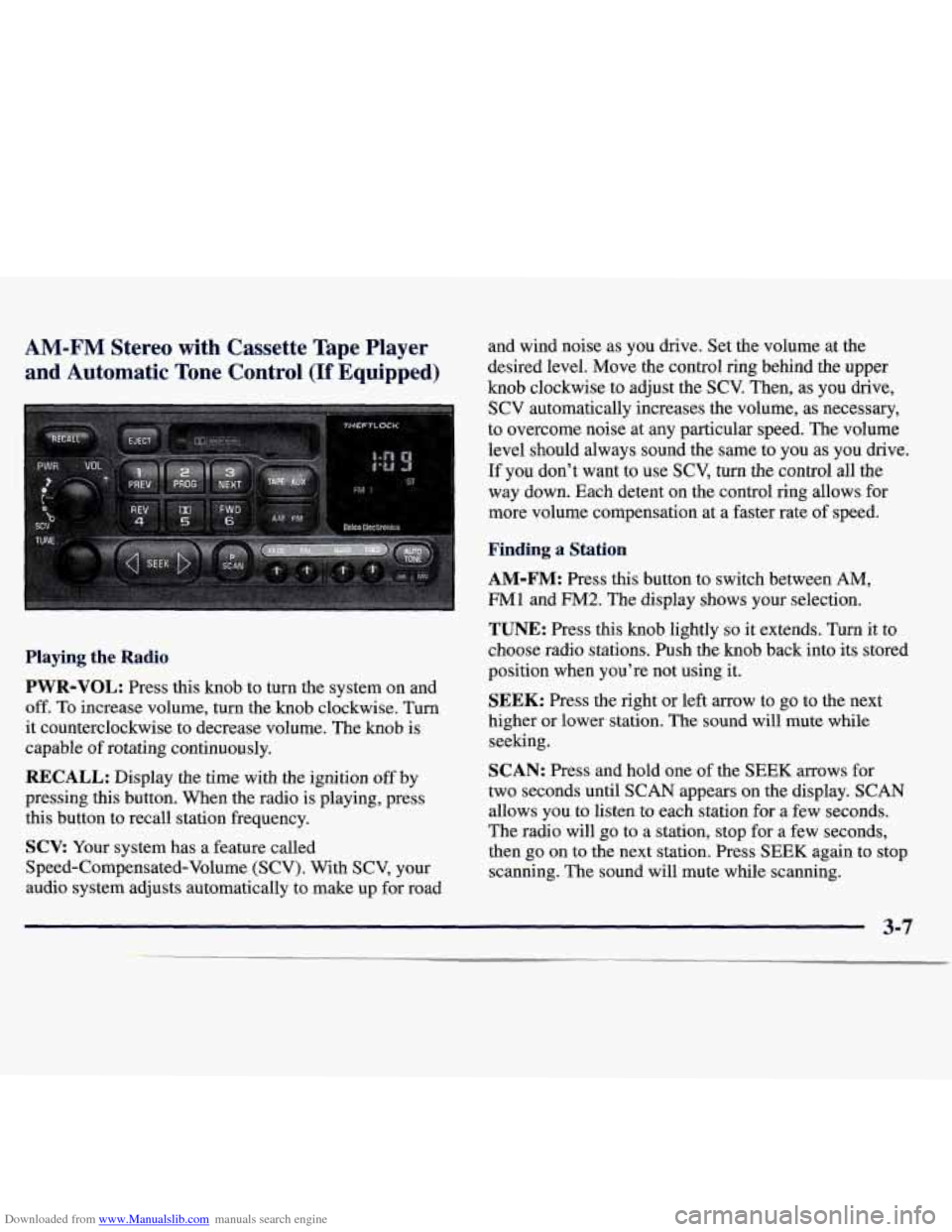
Downloaded from www.Manualslib.com manuals search engine AM-FM Stereo with Cassette Tape Player and Automatic
Tone Control (If Equipped)
Playing the Radio
and wind noise as you drive. Set the volume at the
desired level. Move the control ring behind the upper
knob clockwise to adjust the SCV. Then, as you drive,
SCV automatically increases the volume, as necessary,
to overcome noise at any particular speed. The volume
level should always sound the same to you as you drive.
If you don’t want to use
SCV, turn the control all the
way down. Each detent on the control ring allows for
more volume compensation at a faster rate of speed.
Finding a Station
AM-FM: Press this button to switch between AM,
FM1 and F442. The display shows your selection.
TUNE: Press this knob lightly so it extends. Turn it to
choose radio stations. Push the knob back into its stored
position when you’re not using
it.
PWR-VOL: Press this knob to turn the system on and
off. To increase volume, turn the knob clockwise. Turn
it counterclockwise to decrease volume. The knob is
capable of rotating continuously.
RECALL: Display the time with the ignition off by
pressing this button. When the radio is playing, press
this button to recall station frequency.
SCV: Your system has a feature called
Speed-Compensated-Volume (SCV). With SCV, your
audio system adjusts automatically to make up for road
SEEK: Press the right or left arrow to go to the next
higher or lower station. The sound
will mute while
seeking.
SCAN: Press and hold one of the SEEK arrows for
two seconds until
SCAN appears on the display. SCAN
allows you to listen
to each station for a few seconds.
The radio will
go to a station, stop for a few seconds,
then
go on to the next station. Press SEEK again to stop
scanning. The sound will mute while scanning.
3-7
Page 127 of 358
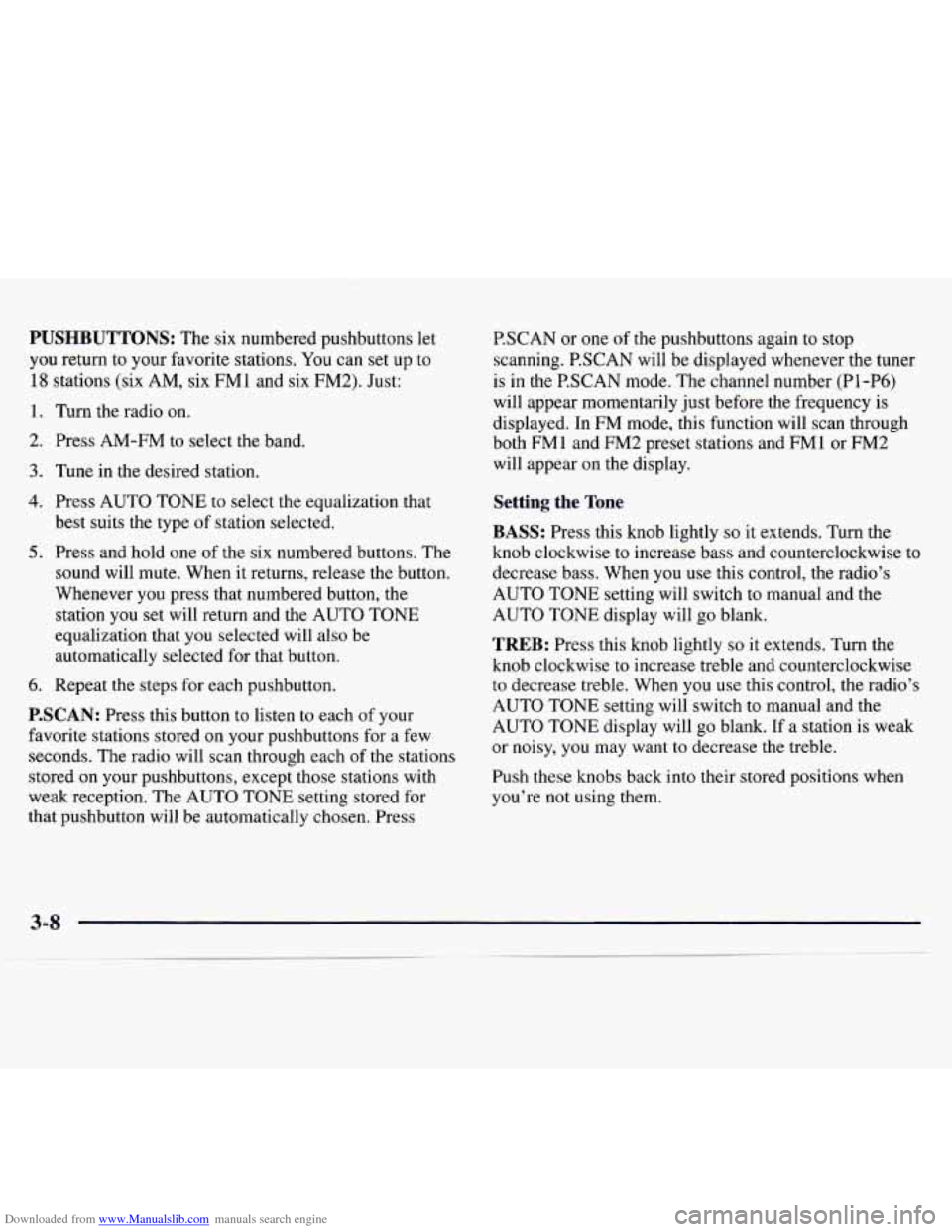
Downloaded from www.Manualslib.com manuals search engine PUSHBUTTONS: The six numbered pushbuttons let
you return to your favorite stations. You can set up to
18 stations (six AM, six FMl and six FM2). Just:
1.
2.
3.
4.
5.
6.
Turn the radio on.
Press AM-FM to select the band.
Tune in the desired station.
Press AUTO TONE to select the equalization that
best suits the type of station selected.
Press and hold one of the six numbered buttons. The
sound will mute. When it returns, release the button.
Whenever you press that numbered button, the
station you set will return and the AUTO TONE
equalization
that you selected will also be
automatically selected for that button.
Repeat the steps for each pushbutton. P.SCAN
or one of the pushbuttons again to stop
scanning. P.SCAN will be displayed whenever the tuner
is in the PSCAN mode. The channel number (Pl-P6)
will appear momentarily just before the frequency is
displayed. In FM mode, this function will scan through
both FMl and FM2 preset stations and FMl or FM2
will appear on the display.
Setting the Tone
BASS:
Press this knob lightly so it extends. Turn the
knob clockwise to increase bass and counterclockwise to
decrease bass. When
you use this control, the radio’s
AUTO TONE setting will switch to manual and the
AUTO TONE display will go blank.
TREB: Press this knob lightly so it extends. Turn the
knob clockwise to increase treble and counterclockwise
to decrease treble. When you use this control, the radio’s
~ ~
P.SCAN: Press this button to listen to each of your
favorite stations stored on your pushbuttons for a few
seconds. The radio will scan through each of the stations AUTO TONE setting will
switch to manual and the
AUTO TONE display will go blank. If a station is weak
or noisy, you may want to decrease the treble.
stored on your pushbuttons, except those stations with Push these knobs back into their stored positions when
weak reception. The AUTO TONE setting stored for you’re not using them.
that pushbutton will be automatically chosen. Press
Page 128 of 358
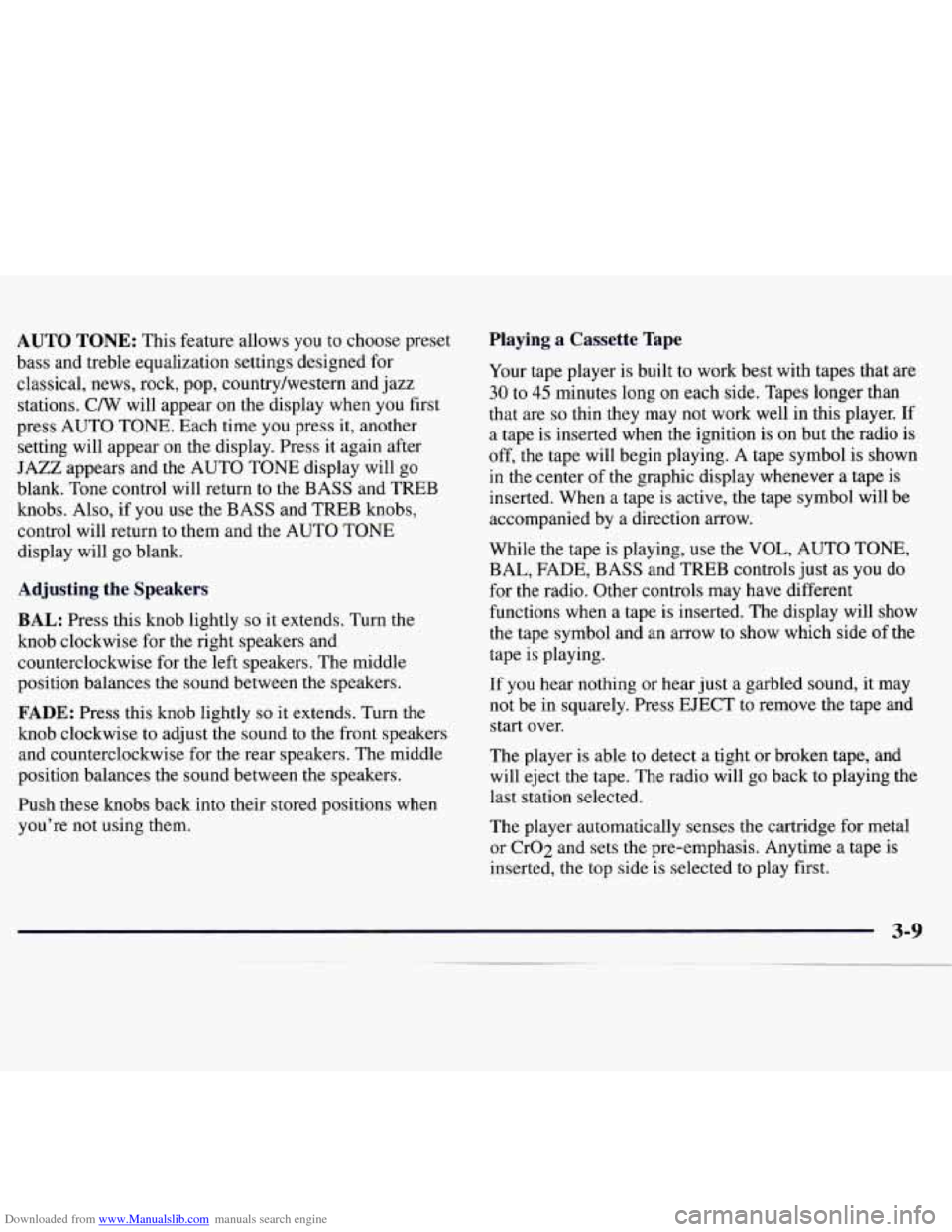
Downloaded from www.Manualslib.com manuals search engine AUTO TONE: This feature allows you to choose preset
bass and treble equalization settings designed for
classical, news, rock, pop, country/western and jazz
stations. C/W will appear on the display when you first
press AUTO TONE. Each time you press it, another
setting will appear on the display. Press it again after
JAZZ appears and the AUTO TONE display will go
blank. Tone control will return to the
BASS and TREB
knobs. Also, if you use the BASS and TREB knobs,
control will return to them and the AUTO TONE
display will go blank.
Adjusting the Speakers
BAL: Press this knob lightly so it extends. Turn the
knob clockwise for the right speakers and
counterclockwise for the left speakers. The middle
position balances the sound between the speakers.
FADE: Press this knob lightly so it extends. Turn the
knob clockwise to adjust the sound to the front speakers
and counterclockwise for the rear speakers. The middle
position balances the sound between the speakers.
Push these knobs back into their stored positions when
you’re not using them.
Playing a Cassette Tape
Your tape player is built to work best with tapes that are
30 to 45 minutes long on each side. Tapes longer than
that are
so thin they may not work well in this player. If
a tape is inserted when the ignition is on but the radio
is
off, the tape will begin playing. A tape symbol is shown
in the center of the graphic display whenever a tape is
inserted. When a tape is active, the tape symbol will be
accompanied by a direction arrow.
While the tape
is playing, use the VOL, AUTO TONE,
BAL, FADE,
BASS and TREB controls just as you do
for the radio. Other controls may have different
functions when a tape is inserted. The display will show
the tape symbol and an arrow to show which side of the
tape is playing.
If you hear nothing or hear just a garbled sound,
it may
not be in squarely. Press EJECT to remove the tape and
start over.
The player is able to detect a tight or broken tape, and
will eject the tape. The radio will
go back to playing the
last station selected.
The player automatically senses the cartridge for metal
or Cr02 and sets the pre-emphasis. Anytime a tape is
inserted,
the top side is selected to play first.
Page 129 of 358
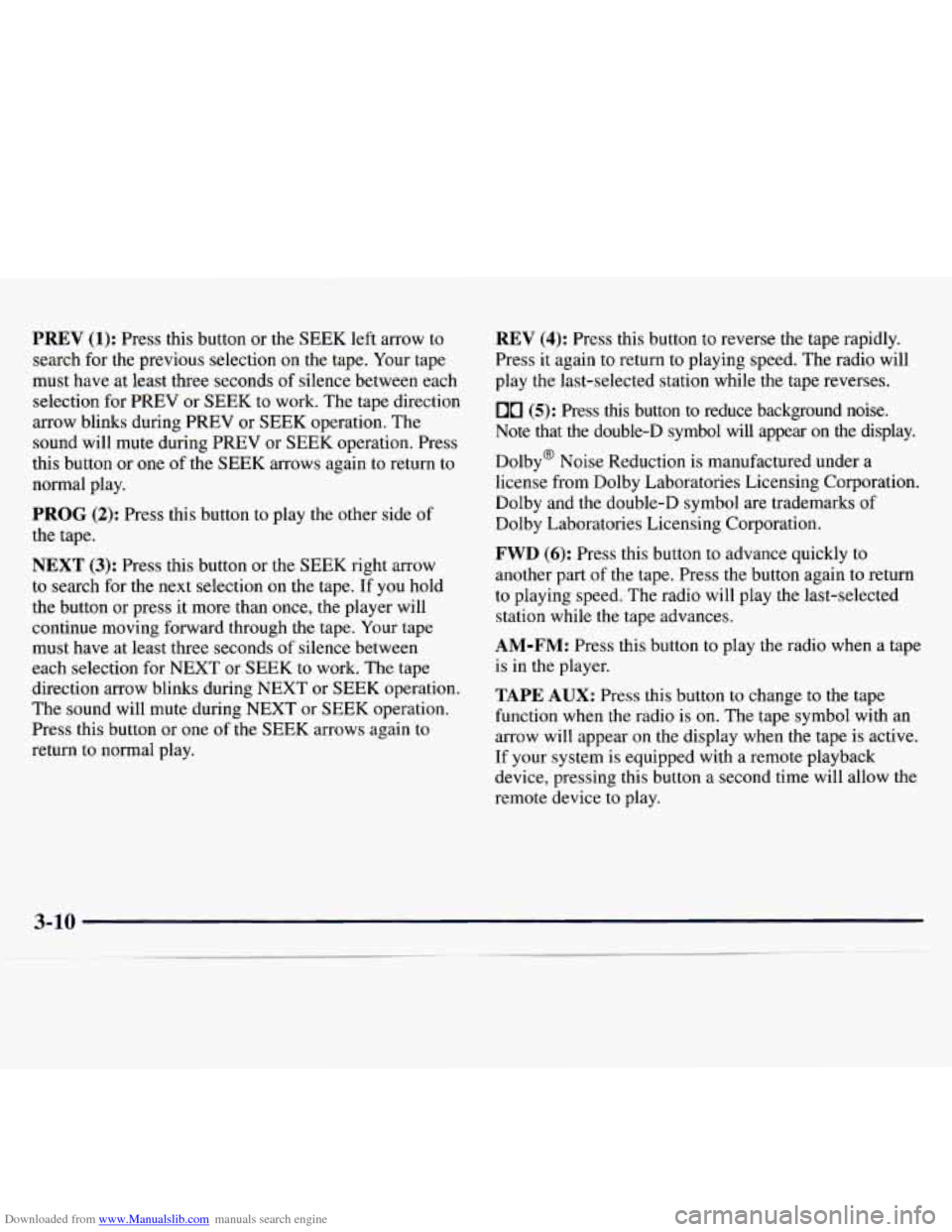
Downloaded from www.Manualslib.com manuals search engine PREV (1): Press this button or the SEEK left arrow to
search for the previous selection on the tape. Your tape
must have at least three seconds of silence between each
selection for PREV or SEEK to work. The tape direction
arrow blinks during PREV or SEEK operation. The
sound will mute during PREV or SEEK operation. Press
this button or one of the SEEK arrows again to return to
normal play.
PROG (2): Press this button to play the other side of
the tape.
NEXT (3): Press this button or the SEEK right arrow
to search for the next selection on the tape. If you hold
the button or press it more than once, the player will
continue moving forward through the tape.
Your tape
must have at least three seconds
of silence between
each selection for NEXT or SEEK to work. The tape
direction arrow blinks during NEXT or SEEK operation.
The sound will mute during NEXT or SEEK operation.
Press this button or one of the SEEK arrows again to
return to normal play.
3-10
REV (4): Press this button to reverse the tape rapidly.
Press it again to return
to playing speed. The radio will
play the last-selected station while the tape reverses.
00 (5): Press this button to reduce background noise.
Note that the double-D symbol will appear on the display.
Dolby@ Noise Reduction is manufactured under a
license from Dolby Laboratories Licensing Corporation.
Dolby and the double-D symbol are trademarks of
Dolby Laboratories Licensing Corporation.
FWD (6): Press this button to advance quickly to
another part of the tape. Press the button again to return
to playing speed. The radio will play the last-selected
station while the tape advances.
AM-FM: Press this button to play the radio when a tape
is in the player.
TAPE AUX: Press this button to change to the tape
function when the radio is
on. The tape symbol with an
arrow will appear on the display when the tape
is active.
If your system is equipped with a remote playback
device, pressing this button a second time will allow the
remote device to play.
Page 130 of 358
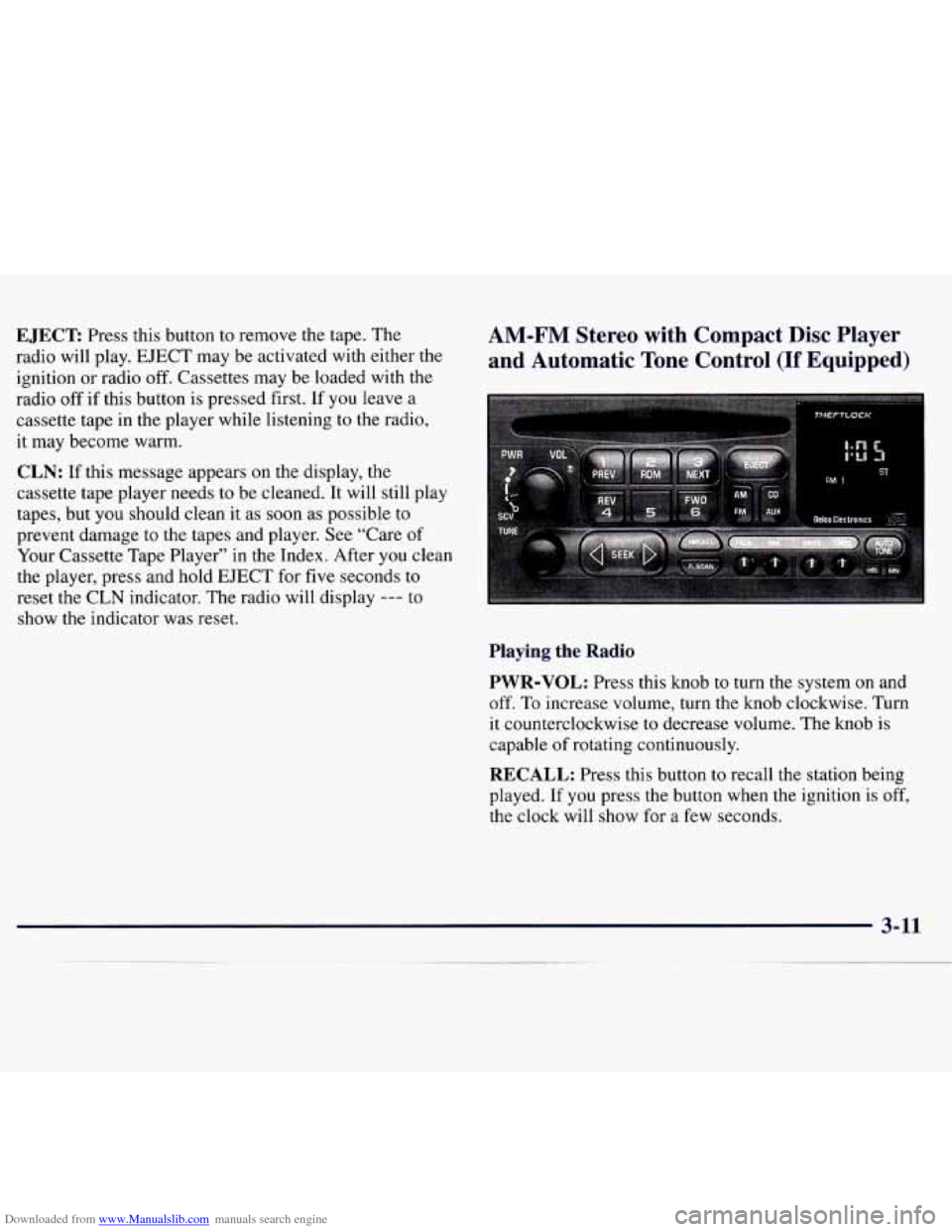
Downloaded from www.Manualslib.com manuals search engine EJECT: Press this button to remove the tape. The
radio will play. EJECT may be activated with either the
ignition or radio off. Cassettes may be loaded with the
radio
off if this button is pressed first. If you leave a
cassette tape in the player while listening to the radio,
it may become warm.
CLN: If this message appears on the display, the
cassette tape player needs to be cleaned. It will still play
tapes, but you should clean it as soon as possible to
prevent damage to the tapes and player. See “Care of
Your Cassette Tape Player” in the Index. After you clean
the player, press and hold EJECT for five seconds to
reset the CLN indicator. The radio will display
--- to
show the indicator was reset.
AM-FM Stereo with Compact Disc Player and Automatic Tone Control
(If Equipped)
Playing the Radio
PWR-VOL:
Press this knob to turn the system on and
off.
To increase volume, turn the knob clockwise. Turn
it counterclockwise to decrease volume. The knob is
capable of rotating continuously.
RECALL: Press this button to recall the station being
played. If you press the button when the ignition is off,
the clock will show for a few seconds.